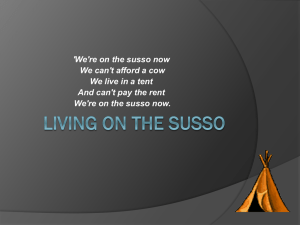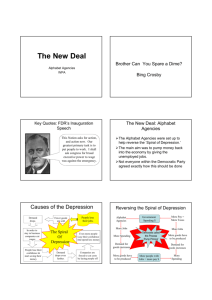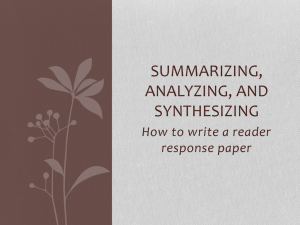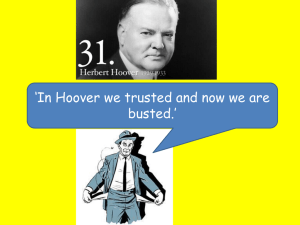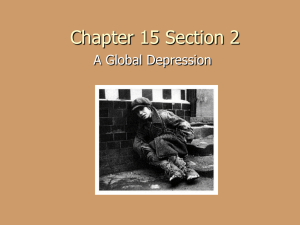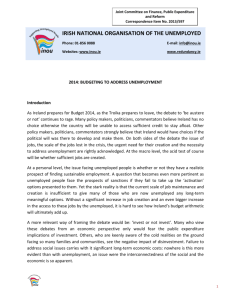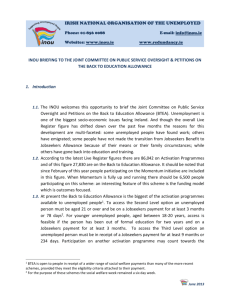The Depression: How did it end?
advertisement
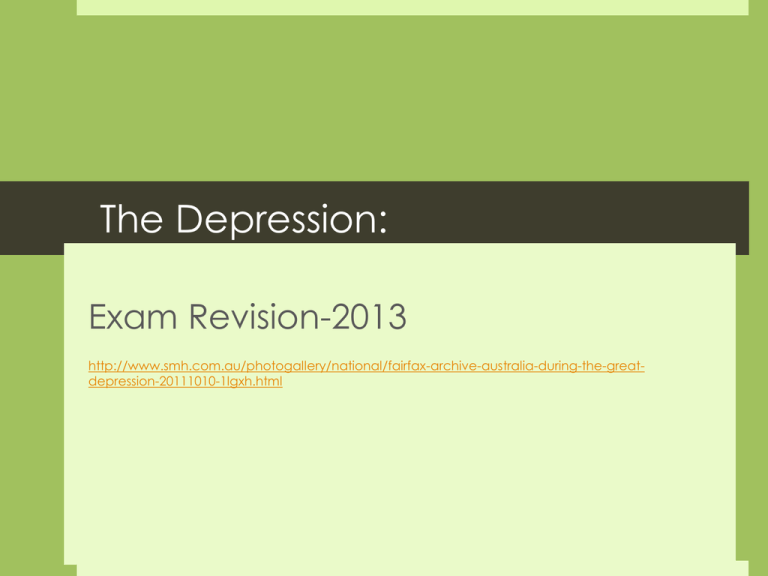
The Depression: Exam Revision-2013 http://www.smh.com.au/photogallery/national/fairfax-archive-australia-during-the-greatdepression-20111010-1lgxh.html ‘Cohesion and Mutual Support were far more significant during the great depression, than division and disunity.’ To what extent do you agree? (2012 Exam Question) Make a comment in your introduction about how there was great support for individuals, families and groups during the period, but also division, disunity, mistrust and a sense of inequality, or some statement that relates directly to the prompt. Ensure that your response shows that there were more than one side to the questions, yes, but also…. Positive responses of cohesion Families taking in relatives Institutions and government schemes (Victorian Relief Fund) Food kitchens Restaurant owners putting leftover food on top of bins instead of in them, corner shops giving food ‘on tick’ and allowing credit Sydney Meyer’s staff serving Christmas dinners voluntarily Charities Charities providing blankets and food for struggling families, Salvation Army, (Soup, Soap and Salvation) Wesley Mission, St Vincent de Paul, Brotherhood of St Lawrence In 1932 ‘St Mark’s Church Hall in Fitzroy fed 240 children each day in 1932, (Sun Newspaper, June 1932) (The year that the Depression reached it’s height) The St Vincent de Paul society, run by layman Charles Edward Fox, was dedicated to helping the unemployed and the needy. They reportedly made more than 16,000 house calls a year, distributing 14,000 garments, 2,300 pairs of shoes and helping any other way they could as they went. ‘NIGHT REFUGE’ CHARITIES ‘Several charities provided ‘night refuges’ for the homeless. Beds were sometimes made only of chicken wire and straw filled padding. ‘Inmates’ were also usually provided with a meal each day, usually stewed meat, vegetables, bread and jam, and tea. They were often asked to leave during the day, but could book a bed for that night. Some charities provided a weekly hot bath and fumigation services for verminous clothing. Individual examples of generosity Businessmen extended generosity to the unemployed. McPherson Robertson funded a bridge over the Yarra, creating employment, and also endowed a girls’ school Sidney Myer provided Christmas lunch or over 1000 unemployed people and created a bargain basement shop where only Australian made good were sold Councils Councils in suburbs such as Brighton and Kew set up ‘Adopt a Child’ schemes, sending food, clothing and school materials to children in poorer areas Co-operation Union groups such as The Unemployed Workers’ Union which ran courses to teach new skills and fought evictions Also, they supported people facing evictions and there are examples of groups of them surrounding the houses of families about to be evicted In Richmond, Victoria, 1931, Real Estate agents were targeted by the UWM for discrimination and had their windows smashed in targeted and planned attacks. This resulted in the Hogan Govt introduced an 8 shilling rent subsidy Co-operation in Government Governments, both state and federal, provided support for the unemployed through the Susso (welfare payments) and various work schemes such as building The Yarra Boulevard) Not always well received though. From 1931-1932 the govt made men work for rations Spencely argues that this was seen as a way of ‘disciplining the workers’ Political Division ALP split Sacking of Lang Frequency of elections Division and disagreement as to the best way to deal with the Depression (conflicting ideas with plans and Susso allocations/dole payments All states had variations on Susso and Dole schemes and who received what Evidence of a discriminatory attitude towards the unemployed from government employees dispensing the dole; some were very invasive, judgmental and/or patronizing Rise of Radical Politics Rise of the radical right wing movements that were pro-monarchy and anti-communist such as Eric Campbell’s New Guard-published its own paper ‘The Rallying Point’ Opposed the NSW Labor Party and saw unions as the enemy. The All for Australia League (100,000 members by 1932) and the New Guard were Sydney based Drew their membership from middle class professionals such as doctors and solicitors as well as clerks and small business owners The White Army had their own arsenal in case of a communist uprising Left Winged Groups Australian communists blamed capitalism for the Depression Never really inspired huge numbers of supporters but were most vocal in the Unions, where some became leaders The Unemployed Workers Movement was more effective as a voice of the unemployed. 30,000 members by 1930 Led marches and organised demonstrations Effective in helping people find work, organising soup kitchens and teaching practical skills such as carpentry and other trades Also organised accommodation and food depots in shantytowns Exploitation in the workplace Some employers exploited workers by dropping wages and conditions, knowing that workers could not get a job elsewhere Stories of male bosses sexually harassing young women Young workers had to remain perpetually young after they turned 16 so they could keep their job Some women took off their wedding rings so they were not discriminated against for taking jobs from single women Evidence of a lack of safety equipment, long hours with little overtime, bullying in the workplace Racism/Discrimination in the workplace Racist attitudes, previously directed towards nonEuropeans were seen directed to Southern and Eastern Europeans (e.g.. Kalgoorlie riots against Italians) Some cases of discrimination against some new British immigrants Non-unionised men were targeted, e.g.. A White Russian who had no money for Union membership, was burned terribly by steam released on board a boat by union members angry that he wouldn’t join the Waterside Workers Union. Took months for him to recover Family Instability Evidence of family break-ups Divorce figures did not rise but there is evidence of men just ‘jumping the rattler’, abandoning families and escaping their responsibilities as fathers and husbands Increases in domestic violence, drinking and gambling Women having to shoulder the load and both work and do their housework, washing etc Evidence of children being put into homes or orphanages For many, this was a negative time Evidenced in increased Strike actions such as: The Waterside Workers Strike from August 1918-1929 The Timber Workers for most of 1929 The Coal Miners from Feb 1929-1930 Stuart Macintyre claims that ‘These groups of workers resisted their new awards, and each one was bludgeoned into submission after long, violent disputes’ (Macintyre, A Concise History of Australia, (3rd Ed, 2009):177 http://en.wikipedia.org/wiki/File:1929_Timberwork ers_Strike.jpg Women workers Then bring them alive with an anecdote, a name and a place where they lived such as Collingwood Discuss how they had to work, their role change from wife and mother to breadwinner, wife and mother and the consequences of this Maybe they suffered from domestic abuse because their husband was unemployed and had lost face. Maybe they had to resort to backstreet abortions. What was the NATURE of their work? Pay? Conditions? Fears and challenges? Women were economically disadvantaged with wages, and Murial heagney (prominent feminist) argued for them and set new precidents for women in the workplace for the next few decades Which Historians addressed this-Potts, Lowenstein, McInolty? What did they say about this group? Did things change for the wealthy? For the wealthy, or even those who were able to secure full-time work and earn a modest salary during the early 1930s, circumstances for many of them actually improved. Average wages dropped but the cost of living dropped to an even greater extent. This meant that their standards of living actually rose, because they could afford more than before. The Wealthy In response, many of the wealthy men who had business and financial acumen capitalised on the poverty of the less affluent classes. The wealthy did this by purchasing the exceptionally cheap land and homes of those who were no longer able to make their mortgage repayments. For similarly low prices, they also bought businesses and belongings from those who had been forced into bankruptcy. If they were willing to take a risk on the rise of the stock market, some people bought shares when the prices were at all-time lows. Even though the benefits of their purchases were not immediate, if they had enough financial resources at their disposal to keep their assets until the economy improved, these investors reaped the financial benefits Cohesive society Irrespective of wealth/class divide, Australians came together to enjoy films, the races, cricket, the beach, get togethers, board games Phar Lap Body Line Cricket Shirley Temple films Ocean Liners No change Page 185 Macintyre; No changes for women in the workplace but left wing activist women like Muriel Hegenay advocated for change to wages and conditions for women Vacuum of Political leadership, the budgets were eventually balanced, but little faith in the govt Some people experienced no change, “hardly noticed the Depression” Others had a little change, “We Didn’t get as much food as you’d like to give them …..(her children) but they seemed as alert as ever’. (Interview with Ivy ) David Potts, The Myth of the Great Depression, 211-2 Men ordered to present food relief tickets for inspection because of fraud allegations, at the dole queues at No.7 Wharf, Circular Quay, Sydney. 11 June 1931. http://www.smh.com.au/photogallery/national/fairfax-archive-australia-during-the-greatdepression-20111010-1lgxh.html Change By the end of the 30’s, communists held positions of power in many unions and women became more radical in their workplaces ‘The radicalization of the unions was a lasting effect of the Depression’ (Macintyre 184) ‘It made people more saving [sic], more understanding, and stronger….It built character as you fought your way through it, and taught you to put up with things.’ Interview with Ivy; David Potts, The Myth of the Great Depression, 211-2) The period brought about change in the welfare system, public housing and attitudes to the homeless/unemployed People were no longer sitting back and accepting what the government proposed or sanctioned, they fought and protested for better conditions and rights Summary Too many experiences to make an opinion of whether there was more cohesion or disunity Much of the information is based on interviews 40 years after the event (Lowenstein, Potts, Cannon, McCalmon etc.) and we must be mindful of memory distortion What we do have however, is government documents of ration/Susso/Dole cards, photos, songs, newspaper reports (Go to Trove to find examples of ads for clothing, houses, trips on ocean liners)
